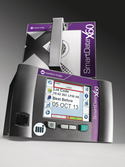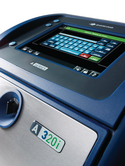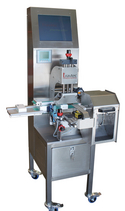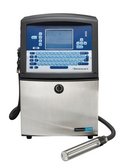Spreading the cost
1 August 2012In coding and marking, leasing programmes now being offered by the major providers are giving flexibility, affordability and predictability at a time of continued uncertainty. Lynda Searby reports
Ongoing financial turbulence in Europe is understandably making packers and processors cautious about investments in new coding and marking equipment, and making leasing a more attractive option.
“We are finding that reduction in capital expenditure budgets and an increased focus on running lines at maximum output is increasingly driving our customers away from outright purchase of coding and labelling systems,” says Martin Bailey, Markem-Imaje UK operations manager.
Domino also confirms that it is experiencing a trend towards leasing coding and marking equipment as a result of the current economic unpredictability.
“In some cases, customers want to at least have visibility of this option, even if they ultimately decide to purchase the equipment outright,” says UK sales manager Jim Orford. “The current environment is definitely an influencing factor in this trend, as customers want to assess all options available to them, and are also exercising greater control over their operational expenditure.”
There are a number of advantages to leasing rather than purchasing coding equipment, as Orford explains: “Leasing agreements allow customers to roll all aspects of their equipment, their fluids supply as well as their servicing requirements, into one convenient, monthly payment. This makes it much easier for budgeting purposes and for the planning of their overall cost of coding on site.”
In addition, he says it gives customers flexibility and future proofing against any change or advances in technological development.
It is no coincidence that the major coding equipment providers have all responded with reassuringly named leasing plans that promise to ‘take the strain off your finances’ and make budgeting easier.
Domino has branded its programme ‘Relax’. The arrangement is said to cover every aspect of ownership, from service and training to technical support and consumables, in a monthly or quarterly instalment. Spare parts, service visits, emergency call-outs and telephone support are all included in the deal. Leasing terms are three or five years, and customers have the option to replace or upgrade the kit at the end of their leasing term. The Relax contract also allows the flexibility to upgrade or add printers for additional lines.
Markem-Imaje’s offering is the ‘Smile’ programme, which the company says is different to leasing programmes offered by its competitors in that Smile covers all parts, and anything classed as a wear part is proactively replaced at the manufacturer’s recommended intervals.
“For example,” says Bailey, “say a pump has a recommended life of 15,000 hours, we will proactively replace it after 15,000 hours rather than waiting until it breaks down.”
The Smile programme can be used to procure any Markem-Imaje equipment, from continuous inkjet to thermal transfer. Bailey says the cost of the programme is generally between £200-250 per month (based on an inkjet coder running 24/5).
Last year, Linx Printing Technologies launched two leasing packages. Its ‘CompleteCode’ option can give customers a new inkjet, large character outer case or laser printer, servicing and maintenance, all consumables, operator training, helpdesk access and on-site support, for a monthly payment equivalent of £10 a day (based on a new Linx 4900 printer on an eight-hour shift, five days a week).
Linx says this ‘all-inclusive’ option is ideal for both existing customers and users of other technology who want to upgrade to Linx, as CompleteCode can often save money in comparison with carrying on with existing equipment.
With the second, more basic option, ‘EasyPay’, the single monthly payment could be as low as £120 (based on a new Linx 4900 printer leased over a 60-month period). This package excludes consumables and servicing though.
But not all processors and packers are going down the leasing route – many are still buying equipment outright. For example, French cosmetics manufacturer Laboratoire Wilson has just invested in a Linx 4900 continuous inkjet printer to mark batch numbers, expiry dates and country of distribution information on the bottom of containers. The pots and bottles are made from a wide range of substrates, from PET, PE, PP and glass to styrene-acrylonitrile (SAN). Linx specified a high performance black ink that could cope with all of these substrates.
Linx has also supplied inkjet coders to another French company, sauces and dressings manufacturer Covinor. Covinor’s production lines were previously equipped with Linx 6200 models, but the time had come to renew the equipment and comply with European standards. Covinor opted for six Linx 7300 Solvers, used for marking best before dates and batch numbers on glass, PET and aluminium containers.
The 7300 Solver is a self-cleaning inkjet printer incorporating an ink system said to deliver up to 40% less solvent use than competing machines, even at low temperatures. Covinor says it particularly appreciates the ability to transfer settings from one machine to another via the USB port, so there is no risk of marking errors.
In Belgium, meanwhile, a Domino A-Series inkjet is said to have increased output at soft drinks producer Evidel since its installation last June. Evidel was looking to expand production to include 5 gallon polycarbonate water bottles and wanted an inkjet printer that would enable it to increase production output.
Evidel already had an A300 unit coding onto the caps of 1 litre and 20cl bottles on its glass bottling line, which it said had proved extremely reliable over the years, hence its decision to opt for Domino’s A320i for this latest project.
The A320i is said to deliver productivity benefits via its i-Tech technology, which monitors and manages the coder for optimum performance. In addition, the A320i uses 90% less system ink and 50% less ink solvent than its predecessor, thanks to the Qube ink system containing the working ink and filters.
The A320i was installed on the glass bottling line to enable Evidel to increase production speeds, while the A300 was transferred to the new polycarbonate line.
“Since introducing the A320i we have achieved a 5% increase in efficiency on our bottling line, and benefited from 100% uptime,” says Niko Claeys, Evidel assistant managing director. “In addition, the Qube ink system which houses the working ink and monitors performance means we still haven’t had to replace the ink.”
What’s new in coding kit?
Despite the economic environment, coding equipment manufacturers are still forging ahead with developments. Last summer saw the launch of the Linx CJ400, a portable continuous inkjet coder that features one-step set-up and an ‘easi-change’ service module, which means that scheduled maintenance is easily completed without the need for a trained technician or costly service calls.
Later in the year, Allen Coding Systems extended its 53 series of thermal transfer coders with the XL model, an affordable system for food, cosmetics and pharmaceutical applications. The coder has a large print area of up to 53 x 80mm and is available in both continuous and intermittent motion for integration into vertical and horizontal form fill and seal systems, primary labellers, thermoformers and over-wrapping equipment. In addition to the larger print area, the 53XL is said to provide many of the advanced features of more expensive thermal transfer units, including 300dpi print resolution, cassette ribbon loading, 600m ribbon capacity and print speeds of up to 400mm/sec.
Achema 2012 (18-22 June) saw Travtec unveil an enhanced version of its Pharmacarton integrated carton handling, coding and verification station, for in-line high resolution printing of lot, expiry and 2D codes. The Pharmacarton Elite is said to be more compact than the standard model, enabling it to fit easily into existing packing lines. The enclosed operating unit and absence of nooks and crannies ensure fast line clearance at the end of each production run, while a redesigned menu-driven touchscreen interface allows simplified operation and easy changeovers, says Travtec.
The latest addition to Videojet’s 1000 Series, the 1710 small character continuous inkjet printer, is designed for applications requiring high contrast, clean codes on dark or difficult-to-mark surfaces.
The Videojet 1710 printer can code up to five lines of high resolution print, reaching speeds of up to 271m/min. It has been engineered to cope with the demands of pigmented inks, which far outperform standard dye-based inks when creating codes on dark surfaces. For example, the special core is engineered for pigmented inks, using an intelligent clustering of filters and components for easy maintenance, and the conical ink reservoir is said to help to minimise the natural effects of pigmented ink settling.
At the same time, the new system is said to be reliable, easy to operate and simple to maintain, thanks to several design features, including Videojet’s ‘advanced clean flow’ printhead. The high efficiency nozzle is said to reduce printhead cleaning through precisely formed ink drops, while the smooth deck allows for easy cleaning.
Capable of up to 1,000mm/sec at 300dpi resolution, the X60, the latest addition to the Markem-Imaje SmartDate thermal transfer range, was designed with high speed food applications in mind. It is also capable of full resin printing at up to 600mm/sec, which means codes will not rub off. The standard 1,100m ribbon reduces waste by 20%, while the long lasting printhead drastically reduces downtime, says Markem-Imaje.
Allen Coding’s 53XL thermal transfer coder has a large print area of up to 53 x 80mm Allen Coding Domino’s A320i is said to deliver productivity benefits via i-Tech technology, which monitors and manages the coder for optimum performance Domino Linx’s 7300 solver is a self-cleaning inkjet printer incorporating an ink system that is said to use up to 40% less solvent than competing machines Linx Capable of up to 1,000mm/sec, the X60 thermal transfer coder from Markem-Imaje was designed for high speed food lines Markem-Imaje The Pharmacarton Elite is an enhanced version of Travtec’s Pharmacarton integrated carton handling, coding and verification station Travtec Videojet’s 1710 small character continuous inkjet printer is designed for applications requiring high contrast, clean codes on dark or difficult-to-mark surfaces Videojet







